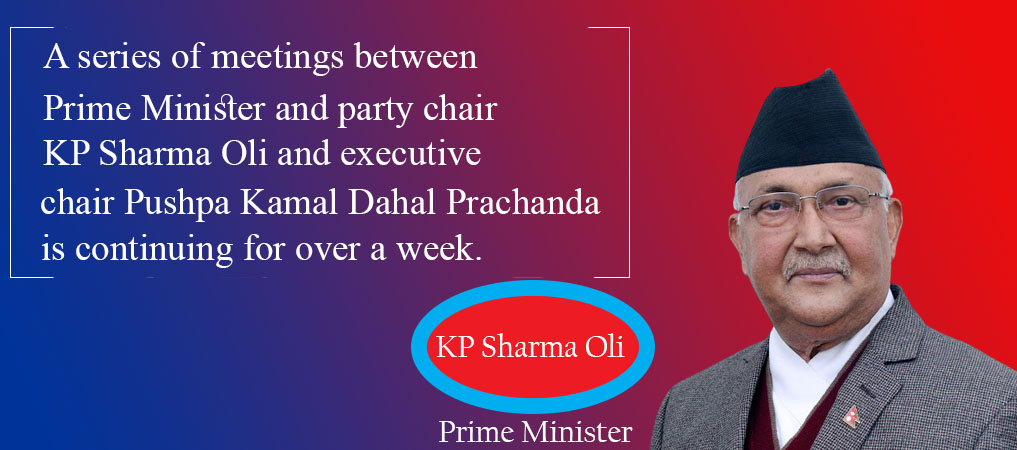PM's efforts focussed on consensus based Cabinet reshuffle

By Ranju Kafle
Kathmandu, Oct. 3: The unity deal has saved the ruling Nepal Communist Party from the brink of division, but the latest parleys to address the intra-party discontent through cabinet overhaul is taking longer time than expected because consensus has become a prominent point to consider.
A series of meetings between Prime Minister and party chair KP Sharma Oli and executive party chair Pushpa Kamal Dahal Prachanda is continuing for over a week. The two chairs obviously have some sticking points to work out before coming up with an agreed list of ministers which demands talks and time.
Prime Minister Oli is under pressure for this reshuffle following the unity agreement that put to rest the long bickering at the top leadership level. Prime Minister Oli has to appoint new ministers in three major ministries-- Finance, Communication and Information Technology and Urban Development, where the portfolios are lying vacant.
He also has to address the demands of those leaders in the ruling party who were dissatisfied with the government and were seeking space for them and the people of their choice in the cabinet.
The Prime Minister has to take the reshuffle decision of three types- whom to remove, whom to retain and the new faces to be inducted. This requires a tight-rope walk for keeping a balance for placating the discontent within the ruling party.
The Prime Minister is sticking to his partial reshuffle plan. “Total overhaul will not occur in cabinet, only vacant seats will be filled soon,” Prime Minister Oli had said some days ago at a formal programme.
This means he has a plan to remove some of the cabinet members on the ground of their performance despite some pressure from the dissenting camp. If there will be complete reshuffle in the present cabinet the Prime Minister will have to face another pressure of even splitting ministries to accommodate candidates from the two factions.
While inducting the ministers, the party has to address the issue of inclusiveness in terms of geography, gender and seniority too. The two chairmen are holding meetings to settle this tricky issue and arriving at a point of agreement may take some more deliberations.
Former minister and leader Surendra Pandey said that the party’s Standing Committee has entrusted the two chairs to resolve the issues and reach a final decision which is expected to come soon.
After assuming the highest executive office for the second time on February 15, 2018, Prime Minister Oli had reshuffled the cabinet for the first time on November 21, 2019. Making exit in this reshuffle were ministers Tham Maya Thapa, Raghubir Mahaseth, Matrika Yadav, Lalbabu Pandit, Gokarna Bista and Chakrapani Khanal.
Performance-based audit was the standard measure for the reshuffle at that time. Those who were not up to the mark to make public delivery were removed. Parbat Gurung, Basanta Nembang, Lekhraj Bhatta, Hridayesh Tripathi, Rameswore Raya Yadav and Ghanashyam Bhusal were inducted as new ministers in the cabinet overhaul.
The Prime Minister’s current reshuffle plan in the third year of government formation is demanding flexibility, some level of compromise and close consultations with his co-chair.
Law expert Kashiraj Dahal is worried about frequent cabinet reshuffles. He said that the ministers will not be able to perform well if they are removed before they have time to work. “Appropriate candidates should be inducted in cabinet and allowed to work full term. This is a challenge to the government,” he added.
Recent News

Do not make expressions casting dout on election: EC
14 Apr, 2022
CM Bhatta says may New Year 2079 BS inspire positive thinking
14 Apr, 2022
Three new cases, 44 recoveries in 24 hours
14 Apr, 2022
689 climbers of 84 teams so far acquire permits for climbing various peaks this spring season
14 Apr, 2022
How the rising cost of living crisis is impacting Nepal
14 Apr, 2022
US military confirms an interstellar meteor collided with Earth
14 Apr, 2022
Valneva Covid vaccine approved for use in UK
14 Apr, 2022
Chair Prachanda highlights need of unity among Maoist, Communist forces
14 Apr, 2022
Ranbir Kapoor and Alia Bhatt: Bollywood toasts star couple on wedding
14 Apr, 2022
President Bhandari confers decorations (Photo Feature)
14 Apr, 2022











